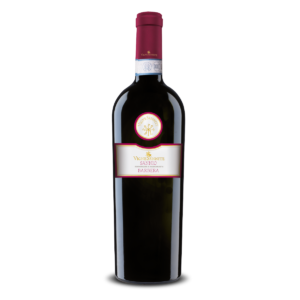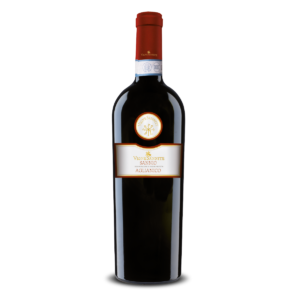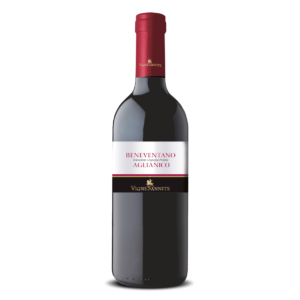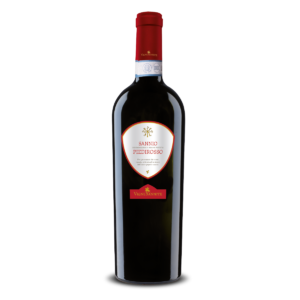Rossi
Barbera
- L’UVA. IL VIGNETO. IL TERRITORIO
- Vitigno la cui presenza nel Sannio è
testimoniata da almeno 2 secoli.
Si e ben adattato in questo ambiente
producendo un vino assolutamente unico
e ad alto livello di piacevolezza.Il clone di questo Barbera non ha niente a
che vedere con quello piemontese anzi si
presume sia un altro vitigno con grappolo
medio grande serrato a bacca ovoidale.
Periodo di maturazione ultima decade di
Settembre prima di Ottobre. - IL VINO
- Dal colore porpora, ha nei profumi fruttati e
floreali la sua massima espressione olfattiva.
Al gusto e secco con sentori di amarena,
rosa passita, caldo, ampio e lungo.
Accompagna primi piatti e secondi dicarni bianche ben condite.
Servire ad una temperatura di 18°C.
- LA VINIFICAZIONE
- Dopo una attenta selezione dei migliori siti
perla produzione del Barbera, le uve conferite
nell’enopolio subiscono una diraspaturae macerazione pellicolare in presenza di
fermentini di solo 100 hl.Segue una fermentazione a temperatura
controllata a 22-25°C., così facendo si ottiene
un prodotto fruttato, morbido e tipico, cheesalta le peculiarità del vitigno e del territorio.
- THE GRAPES AND THE VINEYARD
- A grape variety that has been recorded in Samnium for at least two centuries.
It has adapted perfectly to this environment, giving
rise to a truly unique wine offering a high level of enjoyment. The
clone of this Barbera has nothing to do with that of
Piedmont; on the contrary, itis assumed to be a
different grape variety, with a medium-large close-
packed cluster of oval- shaped grapes. lt ripens in the
last decade of September and the early part of
October. - THE WINE
- Purple in colour, its ultimate olfactory expression is that of fruity, floral perfumes.
It is dry on the palate, with hints of Amarena cherry
and dried rose, with a warm, broad and long flavour. It is a
perfect match with well-garnished first and second courses of white meat.Serve at a temperature of 18° C.
- VINIFICATION
- After careful selection of the best sites for the
production of Barbera, the grapes are delivered to the
Winery where they undergo destemming and
maceration on the skins in
fermentation vats of 100 hl. This is followed by
fermentation at a controlled temperature of 22-25° C.
The result is a fruity, soft and typical wine that
enhances the characteristics of the grape variety and the terroir.
Aglianico
- L’UVA. IL VIGNETO. IL TERRITORIO
- L’Aglianico prende il nome molto
probabilmente da Glianica (uve di pianura)
come descritto da alcuni ampelografi. È un
vitigno molto territoriale e da il suo meglio
sui terreni vulcanici e arenari con forti
escursioni termiche. II clone più presente e
quello dell’Aglianico del Taburno. Uva a bacca
rossa dal grappolo spargolo e medio con acini
regolari, matura dalla seconda decade di
Ottobre ai primi di Novembre. - IL VINO
- Il vino Aglianico ha un colore rosso rubino
tendente al granata con l’invecchiamento,
fruttato con sentori di lampone e prugna, un bouquet ampio e complesso, secco e vellutato.
Vino ideale per accompagnare primi piatti a
base di carne e ragù, secondi di carne rossa
alla griglia. Consigliamo di servirlo ad una
temperatura di 18°C. - LA VINIFICAZIONE
- Dopo una attenta selezione dei migliori siti perla produzione dell’Aglianico, le uve
vengono diradate nel vigneto e poi conferite
nell’enopolio ove subiscono una diraspatura
e macerazione pellicolare in presenza di fermentini di solo 100 hl. Segue una
fermentazione a temperatura controllata a
22-25°C., così facendo si ottiene un prodotto
fruttato, morbido e tipico, che esalta le
peculiarità del vitigno e del territorio.
- THE GRAPES AND THE VINEYARD
- Aglianico very probably takes its name from
Glianica (grapes of the plain) as described by few
ampelographers. This is an extremely territorial grape variety that gives of its best
on volcanic, sandstone solis where the climate
features extreme temperature differences. The most
common clone is the Aglianico del Taburno. It is a red
grape which grows in straggly clusters with regular-
shaped grapes, ripening from the second decade of
October up to early November. - THE WINE
- The Aglianico wine flaunts a ruby red colour tending
to garnet with ageing; it is fruity with hints of
raspberry and plum, a full and complex bouquet, dry
and velvety. Itis a perfect accompaniment to first
courses based on meat or meat sauce, and main
courses ofgrilled red meat.
We recommend serving it at a temperature of 18° C. - VINIFICATION
- After careful selection of the best sites for the
production of Aglianico, the grapes are thinned out in
the Vineyard. after which they are delivered to the
Winery where they undergo destemming and
maceration on the skins in fermentation vats of 100 hl.
This is followed by fermentation at a controlled
temperature of 22-25° C. The result is a fruity, soft and
typical wine that enhances the characteristics of the
grape variety and the terroir.
Piedirosso
- L’UVA. IL VIGNETO. IL TERRITORIO
- Vitigno raro e molto antico, ha trovato nel
Sannio il suo habitat naturale ideale fornendo
vini che esprimono il territorio.
Deve il suo nome alle peculiarità del pedicello
che e completamente rosso.
Il suo grappolo e medio piccolo e spargolo con
acino di media grandezza sferoidale.
Matura nella seconda decade di Ottobre. - IL VINO
- Vino dal colore rosso rubino, fruttato con
sentori di frutta e lamponi. Secco e morbido al
gusto, da tutto pasto si abbina a primi piatti e
secondi a base di carni bianche.
Servire ad una temperatura di 18°C. - LA VINIFICAZIONE
- Dopo una attenta selezione dei migliori siti per
la produzione del Piedirosso, le uve conferite
nell’enopolio subiscono una diraspatura
e macerazione pellicolare in presenza di
fermentini di solo 100 hl.
Segue una fermentazione a temperatura
controllata a 20-22°C., così facendo si ottiene
un prodotto fruttato, morbido e tipico, che
esalta le peculiarità del vitigno e del territorio.
- THE GRAPES AND THE VINEYARD
- This is a rare and very old grape variety, which has
found in Samnium its ideal natural habitat, yielding
wines that are a perfect expression of the terroir. lt
owes its name (redfoot) to the characteristic stalkwhich is completely red. lt grows in medium-small and strageg clusters of
Spherical medium-size grapes, ripening in the second decade of October. - THE WINE
- Wine of a ruby red colour, fruity with hints of fruit
and raspberry. Dry and soft on the palate, it can be
drunk throughout the meal and is perfect with first and second courses based on white meat. Serve at a temperature of 18° C. - VINIFICATION
- After careful selection of the best sites for the
production of Piedirosso, the grapes are delivered to
the Winery where they undergo destemming and
maceration on the skins in fermentation vats of 100 hl. This is
followed by fermentation at a controlled
temperature of 22-25° C.
The result is a fruity, soft and typical wine that
enhances the characteristics of the grape variety and the terroir.





